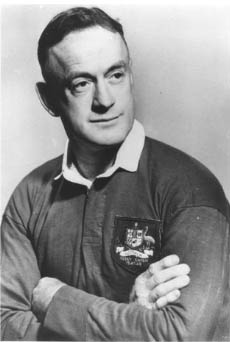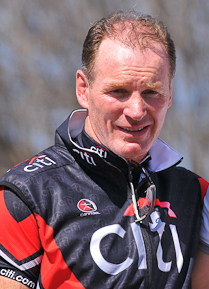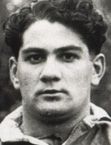Related Research Articles

Cyril Towers was an Australian rugby union player, a state and national representative centre who made 57 appearances for the Wallabies, played in 19 Test matches and captained the national team on three occasions in 1937.

Morgan Turinui is an Australian rugby union footballer who currently is a rugby commentator for Stan Sport and Channel Nine in Australia.

Simon Paul Poidevin is a former Australian rugby union player who played as a flanker. Poidevin made his Test debut for Australia against Fiji during the 1980 tour of Fiji. He was a member of the Wallabies side that defeated New Zealand 2–1 in the 1980 Bledisloe Cup series. He toured with the Eighth Wallabies for the 1984 Australia rugby union tour of Britain and Ireland that won rugby union's "grand slam", the first Australian side to defeat all four home nations, England, Ireland, Wales and Scotland, on a tour. He debuted as captain of the Wallabies in a two-Test series against Argentina in 1986, substituting for the absent Andrew Slack. He was a member of the Wallabies on the 1986 Australia rugby union tour of New Zealand that beat the All Blacks, one of six international teams and second Australian team to win a Test series in New Zealand. During the 1987 Rugby World Cup, he overtook Peter Johnson as Australia's most capped Test player against Japan, captaining the Wallabies for the third time in his 43rd cap. He captained the Wallabies on a fourth and final occasion on the 1987 Australia rugby union tour of Argentina before injury ended his tour prematurely. In 1988, he briefly retired from international rugby, reversing his decision 42 days later ahead of the 1988 Bledisloe Cup series. Following this series, Poidevin returned to the Australian side for the single 1989 Bledisloe Cup Test. He returned full-time to the Australian national squad for the 1991 season. Poidevin was a member of the Wallabies that won the 1991 Rugby World Cup, after which he retired from international rugby union.

Western Sydney Two Blues Rugby, formerly Parramatta Two Blues Rugby, is a rugby union club based in Parramatta, the second CBD of Sydney, Australia. The club was formed in 1879 and competes in the Shute Shield run by the New South Wales Rugby Union. One of the oldest clubs in the Sydney Premier Rugby competition the club has produced nineteen Wallabies over the years, starting with the great Bill Cerutti in 1936 through to the club's current, Tatafu Polota-Nau. To date Parramatta has played in eight First grade grand finals.
Kenneth William Catchpole was an Australian rugby union footballer. A state and national representative half-back, he played twenty-seven matches for Australia, thirteen as captain. Catchpole rose through the ranks at the Randwick club as a young man, before making his debut for New South Wales at only 19 years of age, then captaining Australia at age 21. He is considered one of Australia's greatest rugby scrumhalves.

Sir Nicholas Michael Shehadie, was a Lord Mayor of Sydney (1973–1975) and national representative rugby union captain, who made thirty career test appearances for Australia between 1947 and 1958. He was President of the Australia Rugby Union from 1980 to 1987; in that role he pushed for and succeeded in persuading the International Rugby Board to launch the Rugby World Cup. He is an inductee into both the Australian Rugby Union Hall of Fame and the IRB Hall of Fame.
John Brass is an Australian former rugby union and rugby league footballer – a dual-code international. He made twelve international representative rugby union appearances with the Wallabies from 1966 to 1968 and six representative rugby league appearances for the Kangaroos in 1970 and 1975, as national captain on one occasion.
Ronald James Lisle was an Australian rugby union and rugby league player and a dual code rugby international. He represented the Wallabies in 4 tests in 1961 and the Australia national rugby league team in 13 matches on the 1963 Kangaroo tour.
John Patrick Ballesty is an Australian former national representative rugby union player who also played first-grade rugby league with the Eastern Suburbs club.

Arthur Cooper "Johnnie" Wallace was an Australian rugby union player, a state and national representative three-quarter who captained the Waratahs on 25 occasions in the 1920s as well as representing Scotland early in his career.
Between July 1947 and March 1948 the Australia national rugby union team – the Wallabies – conducted a world tour encompassing Ceylon, Britain, Ireland, France and the United States on which they played five Tests and thirty-six minor tour matches. It was the first such tour in twenty years, since that of the 1927–28 Waratahs, as the 1939–40 Australia rugby union tour of Britain and Ireland tour had been thwarted by World War II. They were known as the Third Wallabies.
Colin "Col" Windon, was a rugby union player and soldier who captained Australia – the Wallabies – in two Test matches in 1951. By age 18 Windon was playing at flanker for his club Randwick in Sydney's Shute Shield. After serving with the Second Australian Imperial Force in the Pacific Theatre during the Second World War, Windon resumed his rugby career in 1946. He was first selected for Australia for their tour of New Zealand that year. Despite the Wallabies losing both their Tests on tour, Windon impressed with his play.
Between October 1966 and March 1967 the Australia national rugby union team – the Wallabies – conducted a world tour on which they played five Tests and thirty-one minor tour matches. Under the captaincy of John Thornett they toured UK, Ireland, France and Canada winning nineteen matches, losing fourteen and drawing three. At one stage they failed to win in four successive matches although in the Test match against England they gave the home side its heaviest defeat in 16 years. The tour marked the climax of the successful "Thornett Era" of Australian Rugby, buoyed by the leadership skills of skipper John Thornett and the outstanding abilities of greats of the game like Ken Catchpole, Peter Johnson and Rob Heming. Dick Marks and Peter Crittle also toured and would later become among the most influential administrators of Australian rugby.
Edward Joseph Fahey was an Australian rugby union player and World War I artilleryman. He was a state and national representative lock forward who made two international rugby tours and who captained the Wallabies on the 1913 Australia rugby union tour of New Zealand.

Peter George Johnson was an Australian international rugby union player. He enjoyed a long state and international career throughout the 1960s and made 92 national appearances for his country. He captained the Australian side in five Test matches.
Philip Vivers Smith was an Australian rugby union international who represented Australia in eight Test matches. He also played rugby league for South Sydney.
Keith Austin Cross was an Australian rugby union international.
Arthur John Buchan was an Australian rugby union international.
Adrian William McDonald is an Australian former rugby union player.
Anthony Michael Charles Moore is an Australian former international rugby union player.
References
- ↑ "Randwick centre to resume in firsts". The Sydney Morning Herald . 21 June 1967.
- ↑ "John Allan Francis". classicwallabies.com.au.
- ↑ "Francis Tears a Hamstring". The Canberra Times . 19 October 1966. p. 32 – via National Library of Australia.